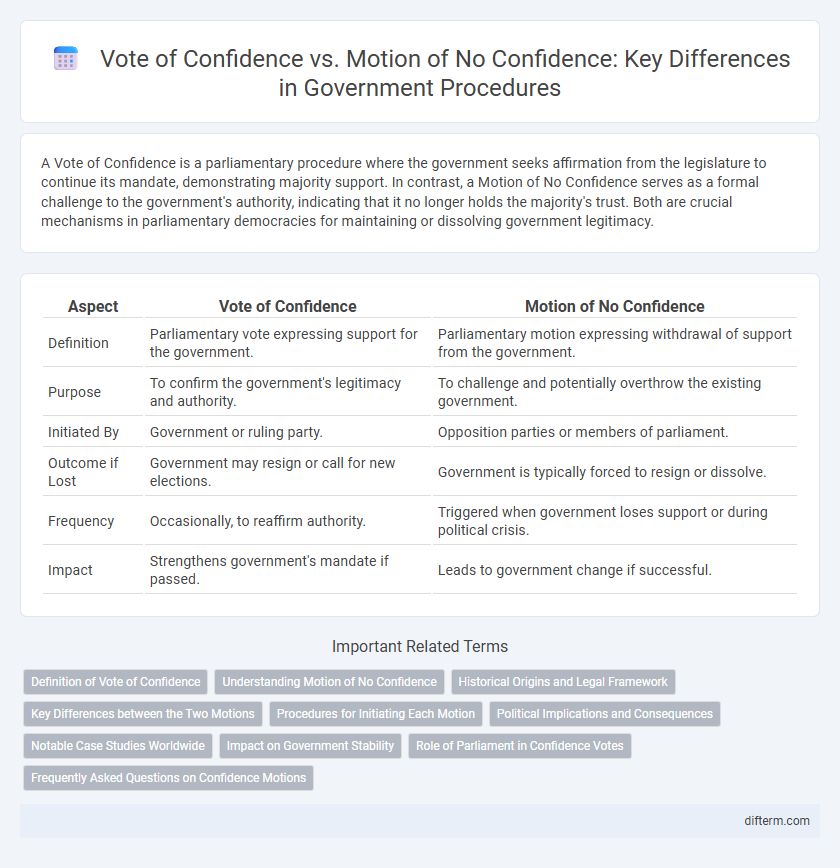A Vote of Confidence is a parliamentary procedure where the government seeks affirmation from the legislature to continue its mandate, demonstrating majority support. In contrast, a Motion of No Confidence serves as a formal challenge to the government's authority, indicating that it no longer holds the majority's trust. Both are crucial mechanisms in parliamentary democracies for maintaining or dissolving government legitimacy.
Table of Comparison
| Aspect | Vote of Confidence | Motion of No Confidence |
|---|---|---|
| Definition | Parliamentary vote expressing support for the government. | Parliamentary motion expressing withdrawal of support from the government. |
| Purpose | To confirm the government's legitimacy and authority. | To challenge and potentially overthrow the existing government. |
| Initiated By | Government or ruling party. | Opposition parties or members of parliament. |
| Outcome if Lost | Government may resign or call for new elections. | Government is typically forced to resign or dissolve. |
| Frequency | Occasionally, to reaffirm authority. | Triggered when government loses support or during political crisis. |
| Impact | Strengthens government's mandate if passed. | Leads to government change if successful. |
Definition of Vote of Confidence
A Vote of Confidence is a parliamentary procedure where the government seeks explicit approval from the legislature to demonstrate its legitimacy and ability to govern. It serves as a formal test of the ruling party's support, usually initiated by the government itself to confirm stability. Passing a Vote of Confidence signifies the government's continued authority, while failure may lead to resignation or dissolution of the legislative body.
Understanding Motion of No Confidence
A Motion of No Confidence is a formal parliamentary procedure used to express that the elected government or a specific leader no longer has the support of the majority in the legislature. It can lead to the resignation of the government or the dissolution of the legislature, triggering new elections. Understanding the Motion of No Confidence is crucial for grasping how parliamentary systems ensure accountability and maintain the balance of power between the executive and legislative branches.
Historical Origins and Legal Framework
The Vote of Confidence and Motion of No Confidence originate from the British parliamentary system, serving as mechanisms to test the government's legitimacy and maintain accountability. Historically, the Vote of Confidence was used to affirm the government's mandate, while the Motion of No Confidence emerged as a tool to challenge and potentially dissolve the ruling administration. Legally, these procedures are codified in parliamentary rules and constitutional provisions, ensuring that governments retain the support of the elected representatives to remain in power.
Key Differences between the Two Motions
A Vote of Confidence is a positive motion initiated by the government to prove its majority support in the legislature, while a Motion of No Confidence is raised by the opposition to demonstrate the government's loss of majority. The key difference lies in their purpose: the Vote of Confidence seeks approval, reinforcing the government's legitimacy, whereas the Motion of No Confidence aims to challenge and potentially topple the government. Outcomes of both motions directly affect the executive's survival, leading to either continued governance or resignation and possible elections.
Procedures for Initiating Each Motion
The procedure for initiating a Vote of Confidence typically involves the head of government or a minister formally requesting the legislature's support to affirm their mandate, often following significant policy announcements or political challenges. In contrast, a Motion of No Confidence is usually initiated by opposition members or dissenting legislators as a formal proposal expressing that the government no longer holds the legislature's support. Both motions require a specified number of signatures or adherence to parliamentary rules to be formally tabled and debated within the legislative body.
Political Implications and Consequences
A Vote of Confidence serves as a formal affirmation of a government's legitimacy, often strengthening its political mandate and stability by demonstrating parliamentary support. In contrast, a Motion of No Confidence challenges the government's authority, potentially leading to its resignation or the dissolution of the legislature, triggering elections or a change in leadership. These mechanisms are critical in parliamentary systems, influencing the balance of power, public trust, and the continuity of governance.
Notable Case Studies Worldwide
The 1979 United Kingdom vote of confidence called by Prime Minister James Callaghan's Labour government led to its downfall amid economic turmoil. In India, the 1999 no-confidence motion against the Atal Bihari Vajpayee government failed decisively, consolidating political stability. Malaysia's 2020 no-confidence motion attempt against Prime Minister Muhyiddin Yassin highlighted parliamentary challenges in a hung parliament scenario.
Impact on Government Stability
A Vote of Confidence reinforces government stability by affirming the ruling party's legitimacy and enabling smooth policy implementation. In contrast, a Motion of No Confidence threatens government stability by signaling parliamentary dissent and potentially triggering government collapse or early elections. The outcomes of these votes directly influence public trust and political continuity within a democratic framework.
Role of Parliament in Confidence Votes
Parliament plays a crucial role in confidence votes by determining the government's legitimacy and ability to govern effectively. A Vote of Confidence is initiated by the government to affirm its support within the legislature, while a Motion of No Confidence is typically proposed by opposition members to challenge the government's authority. The outcome directly impacts the executive's continuation in office, reinforcing parliamentary sovereignty and accountability.
Frequently Asked Questions on Confidence Motions
A Vote of Confidence is a parliamentary procedure where the government seeks explicit support from the legislature to continue its mandate, usually initiated by the ruling party. A Motion of No Confidence is a formal motion introduced by the opposition to challenge the government's legitimacy, requiring the majority to support its continuation. These confidence motions determine the stability of the government and can lead to its resignation or the dissolution of the legislature if the government fails.
Vote of Confidence vs Motion of No Confidence Infographic

 difterm.com
difterm.com